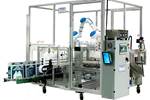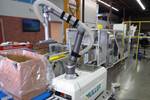Automated Six-Axis Case Packer
Muller Technology says the new six-axis case packer targets high-volume production of lid and container packaging.
Muller Technology has introduced a new six-axis case packer built around an industrial six-axis robot and promising higher productivity than the company‘s recently launched cobot case packer. Targeting high-volume packaging lines, the six-axis case packer offers higher cavitation for production of blow molded bottles and thermoformed or injection molded packaging, handling up to 64 cavities every six seconds for lids, with five second cycles for containers.
The case packer can be purchased separately or integrated into an automation line such as Muller’s new M-Line system, which the company describes as a new integrated robotic and automation system. The basic model of the six-axis case packer can operate as a standalone; be placed at the end of an injection molding or thermoforming machine; or be tied to an in-mold labeling (IML) automation system.
Muller says system offers portability and quick part changeover for different size configurations. It comes with external guarding and all the latest safety features The product platform will be manufactured in Switzerland and Colorado. Muller has already sold several units for lids and containers in the U.S. and Canada.

Muller’s newest automated case packer is built around a six-axis robot to handle higher volumes.
Photo Credit: Muller Technology
Related Content
-
Real-Time Production Monitoring as Automation
As an injection molder, Windmill Plastics sought an economical production monitoring system that could help it keep tabs on its shop floor. It’s now selling the “very focused” digital supervisor it created, automating many formerly manual tasks.
-
How Was K 2022 for Blow Molding?
Over a dozen companies emphasized sustainability with use of foam and recycle, lightweighting and energy savings, along with new capabilities in controls, automation and quick changeovers.
-
Automation Evolution: From Robots to Work Cells, Solo Devices to Integrated Systems
Injection molding automation has progressed from devices to systems, from simplicity to more complex capabilities. The author traces this development through various levels of automation – all still available choices today – and analyzes the costs and capabilities for each level.




.png;maxWidth=300;quality=90)







